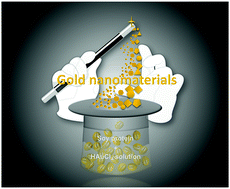Soy protein-directed one-pot synthesis of gold nanomaterials and their functional conductive devices†
Abstract
Gold nanomaterials (NMs), such as gold nanoparticles (NPs), gold nanoclusters (NCs), and gold nanosheets (NSs), attract great interest in many different fields of science and technology, due to their distinct optical, catalytic and conductive properties. Reports of the biogenic formation of gold colloids from gold complexes have also led to an increased level of attention in the biomineralization of gold. However, few methods can be applied in the integrated generation of the multiform and high purity gold NMs. Here, we report the synthesis of stable, water-soluble gold NPs, NCs, and NSs via a facile and green method, using soy protein isolate as reductant, template, and capping agent. The size and shape of the resulting gold NMs can be easily regulated by changing the pH and incubation time. Moreover, by combining the high aspect ratio of gold NSs and the unique properties of soy protein (such as good biocompatibility, easy film-forming features, and satisfactory mechanical properties), we developed a new type of robust, free-standing gold/protein nanocomposite hybrid film, which presents a sensitive response to humidity, showing promise in a vast range of applications, such as biosensors, e-skin and actuators.


 Please wait while we load your content...
Please wait while we load your content...